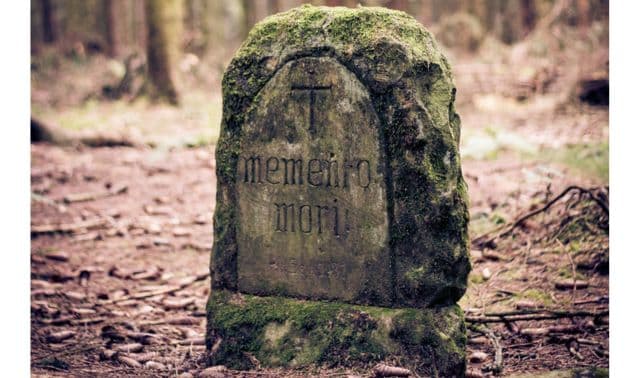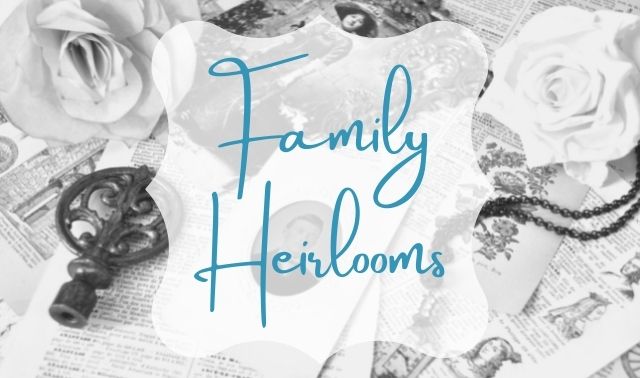Sign up for the Family Tree Newsletter! Plus, you’ll receive our 10 Essential Genealogy Research Forms PDF as a special thank you.
Get Your Free Genealogy Forms
"*" indicates required fields
This article is sponsored by Artifcts.com.
A few years ago, my parents began downsizing from my large childhood home to a smaller “grandparent nest.” It was a lot of work. We were natural collectors, and not so much natural “divesters.” The detritus of eight people’s hobbies and collections filled every corner. Memories of past generations sat on shelves, filled closets, and hung on walls.
Confident I would know what was worth keeping, I started helping my mother sort their belongings. After all, I’d grown up surrounded by them. I’d heard the stories! Right?
Not so much. I assumed our fourth-generation heirloom Seth Thomas clock was a flea market find. (Not so!) I was ready to toss a tattered but colorful corduroy quilt—one that, apparently, my great-grandfather stitched.
As a mother-daughter pair of genealogists, you’d think my mother and I would have come up with a system—right then and there—for documenting all the heirlooms and collectibles. But we never did find a truly workable solution.
Until recently, when I was introduced to Artifcts.com, an online service for preserving and sharing the stories of your favorite objects. I spoke with founders Heather Nickerson and Ellen Goodwin and tried out the site for myself.
My next call was to my mom: “I just bought you a gift subscription you’re going to love!” And she does. As we’ve been Artifct-ing our way around our shelves and basements, we’ve had a lot of fun. And we’re so relieved to finally have a tool to document some of our most prized possessions.
You can try out the site for free, and here are six things a genealogist will love doing at Artifcts.com.
1. Attach Stories to Your Stuff
Usually, an heirloom is special because of the story or memory attached to it. If an heirloom loses its story, it loses much of its value. So the first step at Artifcts.com is to connect your special objects to the memories they hold. They call it “Artifcting.” Here’s the entry I created for my great-grandmother, Jo Wise Henderson.
As you can see, I just took a few quick photos. (I used the website to upload before realizing I could transfer pictures right from my phone with the free Artifcts app at App Store or Google Play.) If I choose, I can record myself talking about the album or paging through it. Maybe later—I wanted to keep things simple as I got started.
When I began writing the description, I hesitated. I suddenly felt obligated to write something beautiful. Ellen calls this common feeling “story burden.”
“Storytelling can become a burden when it’s overwhelming,” says Ellen. “That’s why we made it as easy as possible.”
There’s an encouraging prompt in the description field: “Use 5 words or 500, it’s up to you!” I decided to treat the descriptions like captions in a photo album, not a literary masterpiece. Success! Now Grandma Jo’s album is linked to memories, people and feelings.
Grandma Jo’s album also has a QR code tucked into it that links directly to the Artifct. (See Artifcts.com for suggestions on archival-friendly ways to attach QR codes to your items.) A QR code can be read by anyone with a QR code reader on their phone.
Artifcts works for more than keepsakes. Collectors of all kinds create records of items in their collections, some of which they share with each other. Artisans can inventory their creations. Travelers can log souvenirs and the stories or memories behind them. Parents can snap photos of a child’s artwork or favorite toys to document them without holding on to every scrap of childhood.
2. Ensure Stories Live on for Generations
As genealogists, we hope the knowledge and artifacts we accumulate about ancestors will be passed down. To accomplish this, we need to share both powerfully and permanently. That way, when we die, our stories will not die with us—and our heirlooms won’t all go into an estate sale.
A sad experience like this is actually what led Heather and Ellen to start Artifcts.com. Heather’s mom passed away unexpectedly a few years ago. “As the oldest child and only daughter, I ended up with all her things,” Heather says. “We wanted to keep the things that meant something to her. But we didn’t know which ones did. She hadn’t told us the stories.”
She described her profound disappointment to Ellen, as the two were looking for a business venture to share. They decided to create Artifcts.com so others wouldn’t need to experience the same frustration in the future (including themselves).
I’m already seeing the results from my mom’s Artifcting adventure. One of her first entries was for the Seth Thomas clock:
“It’s nice to have an ability to log what means a lot to you and share it with your kids who will inherit it,” she tells me. “I only wish I knew more about some of my heirlooms.”
Now that I know more about the clock, I’m more intrigued by it. I wonder how old it is, whether it works, and whether it would be a good idea to shine the pendulum or polish the wood. And if someday I have to decide what to do with that clock, I will be much more informed and respectful of its legacy.
Others don’t need a subscription to view your Artifcts. You can enable an option to share all your Artifcts with specific people, or with the general public. As a member, I’ve opted to follow my mom’s profile so I can see all the Artifcts she makes public.
But that’s not the only way Artifcts can safeguard your heirloom stories. “All users can create a Legacy contact,” adds Ellen. “We don’t want your Artifcts lost in cyberspace. Your Legacy contact will inherit your Artifcts account if something happens to you.” You can also name a backup contact.
Your Legacy contact will receive a notification, but doesn’t need to be a subscriber. That person would be able to view and download all your Artifcts, making it easier for your heirlooms’ stories to live on.
3. Declutter without Guilt
Now that I’ve started Artifcting, I’m ready to curate my belongings more intentionally. Some are worth keeping; I just need to Artifct the stories. Other things, I’m ready to let go of—after I Artifct them. Just holding on to the story and memory will be enough.
“We heard from a man whose mother-in-law inherited an enormous collection of family artifacts from a deceased grandfather,” says Ellen. “He said, ‘Please save us! This huge collection absorbs so much time and energy!’ We suggested a gift certificate for the mother-in-law, who’s now going to Artifct the pieces that make her happy, and then declutter without guilt. Now the man’s wife is receiving the stories of those things. It’s a gift for her, too.”
My mom, since she started Artifcting, expresses fresh energy about her ongoing efforts to declutter. Parting with her belongings is challenging. “It might be fair to say that if it’s not worth Artifcting, maybe it’s not worth keeping,” she says. “This will help me make decisions as I’m downsizing and organizing my stuff.”
4. Connect People to Each Other
Artifcting can spark conversations with other relatives, even those who have never expressed interest in genealogy. “You can interact rapidly, and it’s fun!” says Heather. “It’s not a big family tree binder or a boring inventory that nobody may ever look at. And in the process of Artifcting, all kinds of stories come out that nobody has ever thought to ask about or tell.”
Ellen has even used Artifcts to strengthen bonds between her dad and her daughter. “She got this book, Tacky the Penguin, from my dad,” she says. “I have her on video reading it to him. So I Artifcted the video! Now the book itself can go, someday. My dad loved the memories I shared. He said to keep those Artifcts coming!”
She recommends thinking about how to reconnect groups of relatives with Artifcts. “Think about things that might be inaccessible to everyone: in storage, in the attic,” she says. “Share it among siblings or cousins who all have those memories. It gives everyone access to the one object and lets you contribute your own version of the story.”
Sharing is easy on Artifcts. Use the “share” icon in the toolbar that appears on your Artifct image. You can send directly to Artifcts members by typing in their screen names, or share with others by email. You can also copy the link to send people. To share an Artifct on Facebook, Twitter, LinkedIn or Pinterest, you’ll first need to make it publicly viewable.
5. Support Financial and Estate Planning
When it comes time to think about the future, Artifcts also helps with estate planning. You can open an extended form to add an item’s exact location, creator, valuation, provenance or even a warranty. You can attach copies of receipts or other documentation, which may add to your item’s value. This process also makes an estate inventory or valuation easier.
Data can be exported as an Excel file, especially useful for sending to an attorney or insurance agent. The site can also export images, sound files, and videos—all uncompressed, so the data won’t be downsized.
6. Manage Your Privacy
Artifcts adeptly finds the perfect middle ground between privacy/security and providing plenty of sharing options. Heather and Ellen spent their early careers at the CIA, where they worked in data privacy and security. They’ve carefully considered which data should be easy to see—and which shouldn’t.
“Everything, by default, is private,” says Ellen. “You have to choose to share. The privacy fields—location, value and documentation—are never shared. That helps protect your valuables and property.”
Get Started with Artifcts
You have three access options at Artifcts:
- Arti Free (free): Create and share five Artifcts
- Arti Lite ($36/year): Create 30 fully-documented Artifcts each year, and invite other subscribers to add details
- Arti Unlimited ($89 USD/year): Create unlimited Artifcts and add up to three family members or friends to your account
Concierge packages are also available for those who would like hands-on assistance creating their Artifcts.
Those who use Artifcts love the stories of their stuff—and many have made them shareable. Get inspired by browsing what others have posted!
This article is sponsored by Artifcts.com. Originally published, March 2022.








